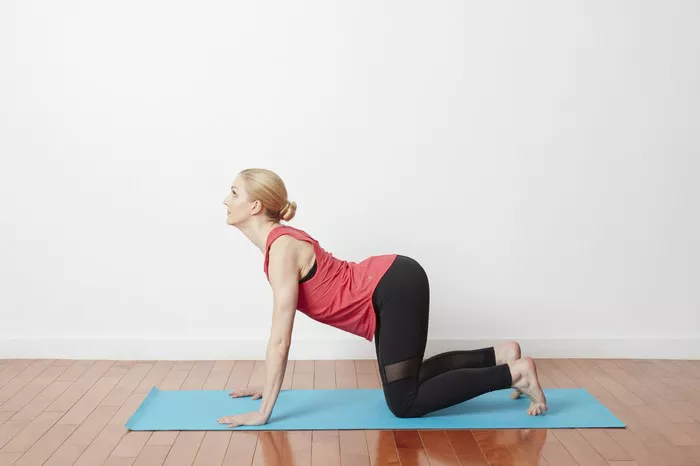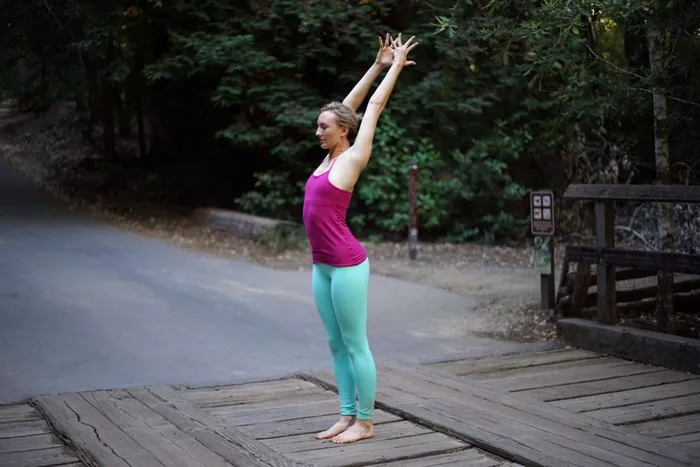Migraines can be debilitating, affecting millions of people worldwide. While medication is often used to manage symptoms, yoga offers a natural and holistic approach to both prevent and relieve migraines. Yoga poses, combined with breathwork and mindfulness, can help reduce stress, tension, and inflammation – all of which are common triggers for migraines. In this article, we’ll explore eight yoga poses that can aid in preventing and alleviating migraines, along with detailed instructions on how to perform each pose safely and effectively.
1. Child’s Pose (Balasana)
Child’s Pose is a gentle yoga posture that helps relax the body and mind, relieving tension in the back, shoulders, and neck.
Steps:
- Begin on your hands and knees in a tabletop position.
- Bring your big toes together and widen your knees apart, allowing your belly to rest between your thighs.
- Lower your hips towards your heels as you extend your arms forward, resting your forehead on the mat.
- Relax your entire body, allowing gravity to gently stretch your spine and release tension in your neck and shoulders.
- Stay in this pose for 5-10 breaths, focusing on deep inhalations and exhalations.
2. Cat-Cow Pose (Marjaryasana-Bitilasana)
Cat-Cow Pose is a dynamic yoga sequence that helps improve spinal flexibility and relieve tension in the back and neck.
Steps:
- Begin on your hands and knees in a tabletop position, with your wrists aligned under your shoulders and your knees under your hips.
- Inhale as you arch your back, dropping your belly towards the mat and lifting your gaze towards the ceiling (Cow Pose).
- Exhale as you round your spine, tucking your chin to your chest and drawing your belly button towards your spine (Cat Pose).
- Continue flowing between Cat and Cow Pose, synchronizing your breath with movement, for 5-10 rounds.
- Focus on elongating the spine and releasing tension with each breath.
3. Forward Fold (Uttanasana)
Forward Fold is a calming yoga pose that helps release tension in the neck, shoulders, and upper back while promoting relaxation.
Steps:
- Stand tall with your feet hip-width apart and your arms by your sides.
- Inhale as you reach your arms overhead, lengthening your spine.
- Exhale as you hinge at the hips, folding forward from your waist and allowing your hands to come to rest on the floor or shins.
- Bend your knees slightly if needed to maintain a straight spine.
- Relax your head and neck, allowing them to hang heavy.
- Stay in this pose for 5-10 breaths, focusing on releasing tension with each exhalation.
4. Legs Up the Wall (Viparita Karani)
Legs Up the Wall is a restorative yoga pose that promotes relaxation and improves circulation, making it beneficial for relieving migraines.
Steps:
- Sit close to a wall with your side body touching it.
- Lie down on your back and extend your legs up the wall, allowing your heels to rest against it.
- Adjust your distance from the wall as needed to find a comfortable stretch in the back of your legs.
- Rest your arms by your sides with your palms facing up.
- Close your eyes and focus on your breath, allowing your body to relax completely.
- Stay in this pose for 5-10 minutes, or longer if desired, breathing deeply and letting go of any tension.
5. Seated Forward Bend (Paschimottanasana)
Seated Forward Bend is a calming yoga pose that stretches the spine, hamstrings, and lower back, promoting relaxation and relieving tension.
Steps:
- Sit on the floor with your legs extended in front of you and your spine tall.
- Inhale as you reach your arms overhead, lengthening your spine.
- Exhale as you hinge at the hips, folding forward from your waist and reaching for your feet or shins.
- Keep your spine straight as you fold forward, leading with your chest.
- Relax your head and neck, allowing them to hang heavy.
- Stay in this pose for 5-10 breaths, breathing deeply and surrendering to the stretch.
6. Reclining Bound Angle Pose (Supta Baddha Konasana)
Reclining Bound Angle Pose is a relaxing yoga pose that opens the hips and groin while promoting relaxation and relieving tension in the lower back and pelvis.
Steps:
- Lie down on your back with your knees bent and the soles of your feet together, allowing your knees to fall open to the sides.
- Adjust the distance of your feet from your pelvis to find a comfortable stretch in your inner thighs and groin.
- Rest your arms by your sides with your palms facing up.
- Close your eyes and focus on your breath, allowing your body to relax completely.
- Stay in this pose for 5-10 minutes, or longer if desired, breathing deeply and surrendering to the stretch.
7. Corpse Pose (Savasana)
Corpse Pose is a deeply relaxing yoga pose that allows the body and mind to fully relax and rejuvenate, making it an excellent choice for preventing and relieving migraines.
Steps:
- Lie down on your back with your legs extended and your arms by your sides, palms facing up.
- Allow your feet to fall open naturally and close your eyes.
- Take a few deep breaths to settle into the pose, allowing your body to relax completely.
- Let go of any tension in your muscles, starting from your toes and working your way up to your head.
- Stay in this pose for 5-10 minutes, or longer if desired, focusing on your breath and allowing yourself to fully surrender.
8. Alternate Nostril Breathing (Nadi Shodhana Pranayama)
Alternate Nostril Breathing is a calming breathing exercise that helps balance the nervous system and reduce stress and tension, making it beneficial for preventing and relieving migraines.
Steps:
- Sit comfortably with your spine tall and your shoulders relaxed.
- Place your left hand on your left knee with your palm facing up.
- Bring your right hand towards your face and place your index and middle fingers between your eyebrows.
- Use your thumb to close your right nostril and inhale deeply through your left nostril.
- Close your left nostril with your ring finger, release your thumb from your right nostril, and exhale completely.
- Inhale deeply through your right nostril, then close it with your thumb and exhale completely through your left nostril.
- Continue this pattern, alternating nostrils with each breath, for 5-10 rounds.
- Focus on the smooth and steady flow of your breath, allowing your body and mind to relax deeply.
Conclusion
Incorporating these yoga poses into your daily routine can help prevent and relieve migraines by reducing stress, tension, and inflammation in the body and mind. Remember to listen to your body and modify the poses as needed to suit your individual needs and abilities. With consistent practice and dedication, yoga can become a valuable tool in managing migraine symptoms and promoting overall well-being.

























